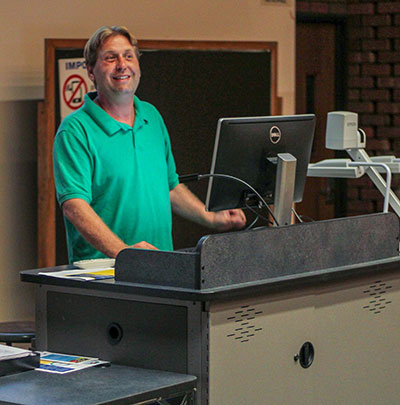
The Scene staff
On the 23rd of August, autumn quietly fell upon us like clockwork after an almost-eternal summer. It was as inevitable as the sun setting.
Three days later, however, in the hollow lecture hall that is C-110, John Snider, St. Louis Community College’s dedicated and equally conversant environmental health and safety specialist, reminded us that the falls of humankind can be prevented.
What seemed like a guaranteed-banal assignment quickly turned into something worth remembering. With only myself, a gaggle of four other students and a faculty member for his audience, Snider delivered a seminar worthy of a crammed auditorium.
Many of us can’t imagine a mortally debilitating fall in our days at campus. The thought of slipping and smacking one’s skull on a Lysol-laden floor doesn’t cross the college-aged mind much.
We tend to assign that kind of clumsy fate to our geriatric loved ones, and statistics will tell you that this presumption is not unfounded, considering nearly one in four people 65 or older take a tumble each year, with less than half even telling their doctors.
However, Snider ominously revealed that an emergency-room-grade fall can be in anybody’s future, given the perfect storm of circumstances.
Innocuous factors, ranging from worn shoe treads to rugs bunched up by foot traffic (a personal pet-peeve of mine) to poor balance due to damaged hearing or even just the distracted mind. … All of these can lead to catastrophic gravity-induced injury.
Slip ratings are even available on all commercially available floor cleaning solutions.

The facts laid before Snider’s audience were enough to give pause, considering the decrepit state of the tread on my sneakers and my innate clumsiness. Note to self: Buy new shoes when the money’s available.
Falls account for nearly 2.8 million emergency-room visits per year, 800,000 of which require hospitalization. These visits are not only physically taxing, but they cost Medicare and Medicaid about $37.5 billion and patients and insurance companies another $12.5 billion.
Seminar attendees included Charles Jones, disability support specialist at Forest Park, who was on a mission to relay some of his new-found knowledge back to his department. With a strong sense of self-assured control, he remarked, “These are things we really take for granted.”
I concurred, aware of my own sense of reckless self-confidence.
“We get comfortable and have this aura of invincibility until we’re not; until we’re not invincible,” Jones continued in a reflective tone. “We’re reminded these things can happen.”
Indeed. And the U.S. Centers for Disease Control completely agrees. It has pithily designated Aug. 23 as “National Fall Prevention Day.”
Snider explained to me that up until April of 2018, his fall-prevention seminars were only available to STLCC faculty. Now students also have the opportunity to attend.
The first week of October, Snider is set to host a series of seminars on fire extinguishers across all campuses.
While topics of personal safety (or safety in general) are admittedly mundane, Snider’s seminars grant them a sobering sense of importance and drive home key points, professionally and eccentrically.
On the college’s website, anybody with login may view Occupational Safety and Health Administration materials, as well as STLCC campus-inspection reports. There’s a lot to be said for transparency at public institutions, and the latter delivers on that value.
During Snider’s seminar, I came to believe the college is undeniably lucky to have a professional who is so passionate about occupational health and safety.
